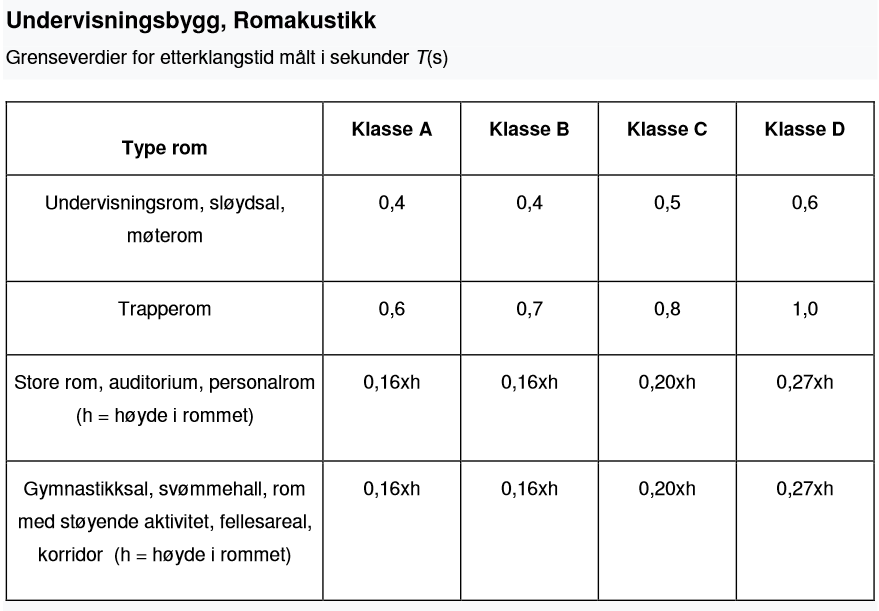Background
Acoustics lies in the interface between AV needs and the technical considerations of building-specific solutions for interiors, architecture, and systems.
This applies to both the construction of new rooms and the renovation/remodeling of existing rooms.
It is important to find a procedure that is easy to follow and involves the right departments/people in the right order, in coordination with project instructions, and this website is the start of that process.
Advice and guidelines for acoustics at the University of Oslo (UiO)
Guidelines and documentation (as of December 2021)
The EA project instructions have few references to acoustics, and historically there has been a focus on material choices and building design to handle noise pollution in the building.
In today's project instruction 5, the acoustics are mentioned by referencing the UFS standards 116 and 119.
Acoustics in AV rooms are better suited in project instruction 2 buildings where the right people can flag it. As of today, Project Instruction 2 Building - 20.10 Acoustics states: "In addition to requirements in applicable laws and regulations, user requirements must always be clarified for both new buildings as well as maintenance and renovation, with regard to instruments that are sensitive to vibrations."
Advising expertise (as of December 2021)
EA (UiO) has an advising engineer who has acoustics expertise and is brought in during the design phase, and that advisor agreement is being renewed.
We currently lack a contact point for ad-hoc evaluations of acoustics in rooms, this is pending a new framework agreement in UNIT for AV suppliers, and also clarification of where this type of consulting expertise can be found.
However, it is possible to order an evaluation of the acoustics in a room, and receive reports with measurements and recommendations for this type of report for hybrid meeting room projects. Contact AV or Bygg-IT if you need help ordering.
SPECIFICATION FROM UNINETT
https://www.uninett.no/sites/default/files/ufs116-oppdatert.pdf
5.5 Acoustics Requirements for acoustic conditions are normally taken care of by an acoustic consultant (RIAku).
Functional requirements for acoustic conditions in buildings are given in the technical regulation accompanying guidance (VTEK10) [4]. Quantified limits are given in the Norwegian standard NS 8175:2012 Sound conditions in buildings - Sound classification of different building types, where the limits for class C are considered sufficient to meet the regulations.
In Statsbygg's project instruction PA 5551 Room acoustics and electro-acoustic systems, examples are shown on how to ensure good conditions for speech communication in auditoriums [5]. See also SINTEF Byggforskserien, especially detail sheet 527.304 Sound regulation in rooms with audiences and 727.304 Improving sound conditions in classrooms.
Sound systems for speech amplification must be adapted to the room acoustic conditions in the room. Note that speech sound systems should be a supplement to, not a replacement for good room acoustic conditions. In some cases, however, there will be a compromise between the optimal design of display surfaces/screens and an acoustic reflector over the podium in auditoriums. See also chapter 10.1 Speaker solutions, chapter 4.2 Display surfaces and projector solutions and chapter 4.6 Sightlines and design of presentation wall.
Additional requirements for rooms for distance education or video conferencing
For rooms that are to be used for distance education, video conferencing or video recording, special requirements are placed on the acoustic conditions. Here, it is particularly important to achieve low background noise, short reverberation time and to avoid strong wall reflections. This is captured in NS8175:2012, where special requirements have been set for video conferencing rooms.
The following additional requirements should be made for video conferencing meeting rooms:
- If you want particularly good room acoustic conditions, class B should be used for reverberation time requirements. The reverberation time should be approximately equal in all octave bands from 125 - 4000 kHz.
- Absorbers must be mounted both in the ceiling and on walls. Hard parallel wall surfaces should be avoided. To ensure a flat reverberation time, different types of absorbers with complementary properties should be used in the ceiling and on wall surfaces.
Note that the need for good room acoustic conditions is at least as great in rooms that are set up with affordable software-based video meeting solutions, as the microphone and speaker solutions often have a poorer sound quality and ability to capture direct sound from the speaker than with traditional video conferencing systems.
See also chapter 10.5.
In auditoriums and seminar rooms, the following conditions should be emphasized:
- If you want particularly good room acoustics, class B should be used for reverberation time requirements. The reverberation time should be approximately equal in all octave bands from 125 - 4000 kHz. (Note: This only applies to rooms characterized as "Larger teaching rooms/auditoriums" in NS8175:2012.)
- Absorbers and any sound-dispersing elements should be placed to avoid reflections from the back wall and flutter echo between the side walls at the podium/speaker position. Reflective surfaces in the ceiling and on side walls should support good speech intelligibility between the speaker and audience.
For reference;
